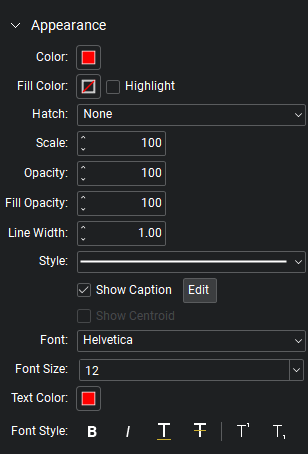Three-Point Radius Measurement
The Three-Point Radius measurement tool places specialized markups that calculate the radius as an arc. While a markup placed with the Three-Point Radius tool can be made into a full circle after it has been placed, it always starts as an arc; to place a circular markup that also calculates the radius of the circle, see Center Radius Measurement.
As with any measurement, be sure to calibrate the document first.
- Go to Tools > Measure >
 3-Point Radius or press SHIFT+ALT+U. The 3-Point Radius measurement mode is engaged.
3-Point Radius or press SHIFT+ALT+U. The 3-Point Radius measurement mode is engaged.- Alternatively, click
 3-Point Radius on the Measurement panel.
3-Point Radius on the Measurement panel.
Note: The keyboard shortcut for the radius measurement tool automatically calls the most recently used version of the tool, either this one or the Center Radius Measurement tool.
- Alternatively, click
- Click to define one end of the arc.
- Click any other point on the arc that is not the other end.
- Click to define the other end of the arc.
The result will be a pie-piece shape with the radius of the implied circle measured.
Tips:
- When drawing an arc using the Three-Point Radius measurement tool, Revu will automatically prevent it from being a full circle. To draw a full circle, either resize the Three-Point Radius markup after it's drawn or use the Center Radius Measurement tool.
- Hold CTRL and click and drag a markup that has already been placed to automatically make a copy of it.
To remove markups from a PDF, select the markup or markups on the PDF or from the Markups list and do one of the following:
- Press DELETE on the keyboard.
- Right-click and select
 Delete.
Delete.
You can add an action to nearly any markup. Simply right-click the markup and select Edit Action to open the Action dialog box.
Select a markup to reveal its control handles. Each handle controls a different aspect of the markup's size and orientation.
To rotate the markup, click and drag the orange handle outside the markup (when the markup is first placed, it will be at the top). By default, the markup is rotated in increments of 15°; to rotate in increments of 1°, hold down SHIFT while dragging.
The rotation can also be entered in the Rotation field found in the Layout section of the Properties panel.
To rotate the caption, click and drag the orange handle directly over it. By default, the markup is rotated in increments of 15°; to rotate in increments of 1°, hold down SHIFT while dragging.To return a rotated caption to its original position, right-click it and select Reset Caption Position.
To change the size of the arc, click and drag one of the yellow handles on the markup's circumference.
- Holding down SHIFT while doing so will change the arc in increments of 15°.
To change the length of the radius, click and drag the yellow handle at the circle's center.
To move the entire markup together, click and drag a part of it other than the control handles.
To scale the markup up or down, click and drag the appropriate purple handle.
The appearance of the Radius measurement is configurable, including line and fill color
To change the appearance of a Radius measurement, select it and click the  Properties panel.
Properties panel.  Properties or press ALT+P to show the
Properties or press ALT+P to show the  Properties panel if it is hidden.
Properties panel if it is hidden.

Color: Sets the line color.
Fill Color: Sets a fill color.
Highlight: Makes the fill color and/or hatch pattern transparent so underlying content shows through.
Hatch: Sets a hatch pattern. The associated color selector sets the line color of the hatch pattern.
Scale: Sets the scale of the hatch pattern, from 50 (half the default scale) to 200 (twice the default scale).
Opacity: Sets opacity level of the line and endpoints, from 0 (invisible) to 100 (opaque).
Fill Opacity: Sets the fill
Line Width: Sets the line thickness in points. A setting of 0 effectively renders the line invisible.
Style: Determines the line pattern.
Show Caption: Select to include caption text on the markup. Click Edit to choose which measurements to include.
Show Centroid: Select to show the geometric center of the shape. If necessary, the caption will be automatically adjusted to be below the centroid.
Font: Sets the font used for the selected text.
- The first region shows all fonts used in the currently selected text element.
- The second region lists the standard PDF fonts that are supported by all PDF viewers. These fonts do not need to be embedded in the PDF when used, thereby cutting down on file size.
- The third shows all other available fonts. When used, these fonts need to be embedded in the PDF.
Note: If you attempt to embed a font for which the viewing and editing permissions do not allow formatting, Revu will display a message indicating the font will not be embedded in the PDF.
Font parameters are retained in the PDF such that even if the original font is not embedded or on the viewer's workstation, a suitable representation of the font will be substituted.
Font Size: Sets the size of the font.
Text Color: Sets the color of text.
Font Style: These settings control the formatting of the text. Options include Bold, Italic, Underline, and Strikethrough. Generally, any combination of these styles can be applied to format the text.